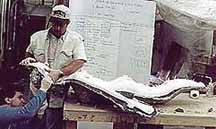Our mold will give us an alien that looks good on the
outside, but it has to look good on the inside , too.
Otherwise we could fill the mold with plaster and start an alien
lawn-statue business.
We want a thick, wet-looking skin, lots of blood and body
fluids, and a set of internal organs. And this isn't a
still-photo shoot, it's a movie - so we'd like our alien to move
in a realistic manner as well. (Yes, it's dead, but it would be
nice if our "examiners" could move it around.)
It's not difficult to build a creature that moves well. It's
not difficult to build a creature that can be autopsied. It IS
difficult to build a single creature that can do both. If we
design our creature with movement as our main goal, the required
mechanical understructure won't leave much room for the internal
organs. If we design it with the autopsy in mind, its thick skin
and lack of skeletal structure will prevent it from moving very
well. Huge, obvious wrinkles will appear at the joints if our
actors try to move the limbs on camera.
Well, it's an autopsy movie, which effectively makes our
choice for us. But it's also part of our job to work with
directors and actors to help show off our effects to their best
advantage. Later, on the set, we'll do our best to obscure the
fact our alien doesn't move.
If we really wanted to do a classy job, we might use our mold
to build two identical bodies - one to move and one to autopsy.
We'd use the first in the preliminary scenes and let the "doctors"
handle it all they liked, then swap in the autopsy version for
the later scenes.
Maybe next time.
Thick-Skinned Aliens
We need space inside our alien for the abdominal organs and
brain. To do this, we suspend a "core" inside our mold
- a plaster blob shaped to fit neatly inside the torso and head.
We place our core to allow the proper amount of airspace between
it and the interior surface of the mold. When we fill the mold,
this airspace will become the skin we cut through to get to the
organs. (We don't need a core for the arms and legs - we'll just
let them fill up with our skin material since we've already
decided not to bother making them posable.)
And what skin material should we use? We have several options,
actually...
- A silicone or gelatin mix will give our alien's skin a nice
"fleshy" quality, if we don't mind the added expense
and complexity.
- Foam latex, a special mixture which expands to form foam
rubber, would give us a body which is soft and spongy, with a
semi-realistic simulation of real flesh. Somewhat tricky to
use, it also requires an oven large enough to bake our entire
mold overnight.
- Polyfoam - a self-rising urethane similar to foam latex but
less expensive and with no overnight baking required - is
quick and cheap. And our alien will look quick and cheap, too,
unless we're very careful!
All of these are workable solutions, subject to our budget,
deadline, and personal preference. If the budget allows, we'd
probably spring for the silicone skin; cuts well, looks more "real",
paints easily.
Just before we close the mold and inject our chosen filling,
we may want to add a bit of structure to certain areas. For
example, we could embed some wires into the fingers so we can
pose the hands. This will mean we can't move the fingers
on-camera... so we won't!
We inject our mold with our chosen filling and wait for it to
set up.
Opening the Mold

A foam body being removed from its mold
We open the mold - voila! An alien. We cut into the corpse's
back and remove the core, leaving a hollow space for our alien
guts.
The head requires a little extra attention because we want to
peel back the skin and reveal a skull. We're not really going to
see very much of this in our final film so all we need to do is
put a solid shape - most likely made of plaster or fiberglass -
into the hollow left behind by the core. In fact we'd probably
use a duplicate of our core to ensure an exact fit.
If we had a bigger budget we might go as far as an
articulated underskull with a hinged jaw and eyelids and so on -
so our "examiner" could fiddle with the eyes and mouth
during the examination. Maybe next time.
We trim and patch the body's seam lines where needed. We give
our little friend a quick paint job - it doesn't have to be very
detailed because we already know this dummy will only be seen in
grainy black-and-white.
We stick oversized eyes in our head and put some sort of film
over them. We'll be removing this covering as part of our "autopsy".
(It won't make a lot of sense, but it'll be icky!)
And we're done.
Oh, almost done. Let's tear out some of the material on the
right thigh, paint a bit of blood on it, and create a big, ugly
"wound". Should take an extra half hour or so.
Let's shoot it!
Next Page...